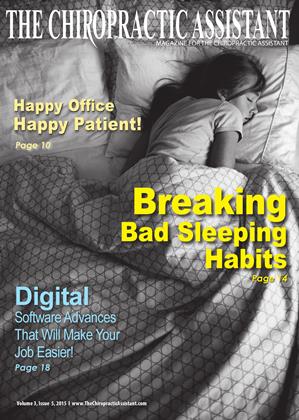Managing Work Stress and Burnout
Keith Giaquinto
The increased need to be productive while reaching higher levels of profitability, yet without any additional manpower, simply produces negative effects on workplace morale.1
With procedures, protocols, and tasks to be tackled daily in the practice, your day can quickly begin to seem overwhelming.
Consistently being overwhelmed can be a subconscious distraction from completing tasks, which can then turn into a slippery slope toward burnout.
Burnout is not good for you, the doctor, or your patients. Another reality of being in practice is that the doctor is expected to provide positive energy to patients all day, and thus must recharge in the evening.
What can you do?
The first thing to do is identify the cause. Realizing that you are consistently more fatigued than usual, that you are procrastinating, and that you don't have the ability to execute your tasks are all signs that you
are on that burnout slope. Collect yourself, take a step back, and assess your situation. Set up a brainstorming staff meeting to help identify what is causing the breakdown.
Once you identify the trouble spot(s) in the daily flow of your tasks, look at them from three perspectives:
• Seriousness — how important is the issue?
• Urgency — separate important issues from urgent issues.
• Growth — look for the opportunity to learn something new from the challenge.
Do not look at the problem as one massive structure, but seek to divide the problem into several parts as if you were reading a book. When issues are divided, they become less cumbersome and easierto address. Further, it is easier to turn some of the issues into smaller, actionable items that can be measured.1
Once this is done, make an action plan, a timeframe to implement the plan, and assign a person to be accountable for the execution of it. This approach can help shine the light on the problem and help diffuse it so that you and the practice can stay strong while serving your community.
Anotherthingto keep in consideration isyou. Make taking care of yourself a priority and develop some healthy boundaries. Remember that you are human and not a superhero. The body can only compensate for so much before it breaks down.
Your body is going to tell you what it needs. Listen to it, take time to recharge your battery, nurture your inner child, get extra adjustments, sleep more, drink plenty of water, and make sure you eat healthy foods and take digestive enzymes to support your body's needs during periods of increased stress.
When you are in the flow of your day, things should be relatively easy and smooth. When you hit a bump in the road, shine some awareness on it. Then lookfor the opportunity to grow from it and course correct.
References:
1. Stevens, Dr. Drew. Practice Acceleration. Phoenix, Greenbranch Publishing, 2013. Page 259-271.
Dr. Keith Giaquinto has more than 12 years of clinical experience as a chiropractor and internal health specialist. He frequently lectures to companies and groups in his community on topics of health and wellness. He has created a new patient lecture system for growing your practice through lecturing. You can contact him at www.drkeithgiaquinto.com
 View Full Issue
View Full Issue






